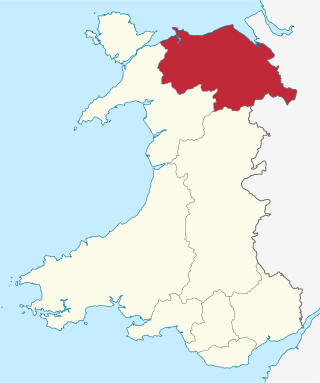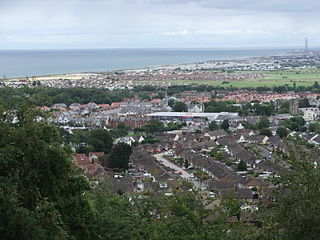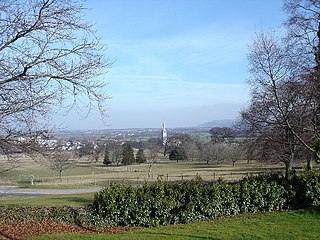Related Research Articles

Denbighshire is a county in the north-east of Wales. It borders the Irish Sea to the north, Flintshire to the east, Wrexham to the southeast, Powys to the south, and Gwynedd and Conwy to the west. Rhyl is the largest town, and Ruthin is the administrative centre. Its borders differ from the historic county of the same name.

Historic Denbighshire is one of thirteen traditional counties in Wales, a vice-county and a former administrative county, which covers an area in north east Wales. It is a maritime county, bounded to the north by the Irish Sea, to the east by Flintshire, Cheshire and Shropshire, to the south by Montgomeryshire and Merionethshire, and to the west by Caernarfonshire.

Rhyl is a seaside town and community in Denbighshire, Wales. The town lies within the historic boundaries of Denbighshire, on the north-east coast of Wales at the mouth of the River Clwyd.

Clwyd is a preserved county of Wales, situated in the north-east corner of the country; it is named after the River Clwyd, which runs through the area. To the north lies the Irish Sea, with the English ceremonial counties of Cheshire to the east and Shropshire to the south-east. Powys and Gwynedd lie to the south and west respectively. Clwyd also shares a maritime boundary with Merseyside along the River Dee. Between 1974 and 1996, a slightly different area had a county council, with local government functions shared with six district councils. In 1996, Clwyd was abolished, and the new principal areas of Conwy County Borough, Denbighshire, Flintshire and Wrexham County Borough were created; under this reorganisation, "Clwyd" became a preserved county, with the name being retained for certain ceremonial functions.

St Asaph is a city and community on the River Elwy in Denbighshire, Wales. In the 2011 Census it had a population of 3,355, making it the second-smallest city in Britain in terms of population and urban area. It is in the historic county of Flintshire.

Denbigh is a market town and a community in Denbighshire, Wales. Formerly, the county town, the Welsh name translates to "Little Fortress"; a reference to its historic castle. Denbigh lies near the Clwydian Hills.

Abergele is a market town and community, situated on the north coast of Wales between the holiday resorts of Colwyn Bay and Rhyl, in Conwy County Borough and in the historic county of Denbighshire. Its northern suburb of Pensarn lies on the Irish Sea coast. Abergele and Pensarn railway station serves both resorts. Abergele is often overlooked due to the popularity of towns in nearby Rhyl, Prestatyn, Colwyn Bay, Llandudno and Conwy. Only 46.5% of the population was born in Wales as of the 2011 census.

Bodelwyddan is a village, electoral ward and community in Denbighshire, Wales, approximately 5 miles (8 km) South of Rhyl. The Parish includes several smaller hamlets such as Marli and Pengwern.

Colwyn was a local government district with borough status from 1974 to 1996, being one of six districts in the county of Clwyd, north-east Wales.

North Wales is a region of Wales, encompassing its northernmost areas. It borders mid Wales to the south, England to the east, and the Irish Sea to the north and west. The area is highly mountainous and rural, with Snowdonia National Park and the Clwydian Range and Dee Valley, known for its mountains, waterfalls and trails, wholly within the region. Its population is concentrated in the north-east and northern coastal areas, with significant Welsh-speaking populations in its western and rural areas. North Wales is imprecisely defined, lacking any exact definition or administrative structure. It is commonly defined administratively as its six most northern principal areas, but other definitions exist, with Montgomeryshire historically considered to be part of the region.
The Vale of Clwyd is a tract of low-lying ground in the county of Denbighshire in north-east Wales. The Vale extends south-southwestwards from the coast of the Irish Sea for some 20 miles forming a triangle of low ground bounded on its eastern side by the well-defined scarp of the Clwydian Range and to the west by numerous low hills. The River Clwyd which rises within Clocaenog Forest, southwest of Denbigh, runs the full length of the vale. It is joined by the two major left bank tributaries of the River Clywedog and River Elwy and the smaller right bank tributary of the River Wheeler.
North East Wales NHS Trust was an NHS Trust in Wales. The headquarters of the Trust were in the Maelor Hospital, in Wrexham. It was founded on 1 April 1999, when the NHS Trusts in Wales were reconfigured. The Trust provided secondary care services for the Wrexham and Flintshire Local Authority areas, including mental health care – a population of around 300,000 people, through one major acute hospital, five community hospitals, and a variety of clinics. The Trust reported a budget deficit of £3.6 million at the end of the 2005/06 financial year.

H.M. Stanley Hospital was a community hospital in St Asaph, Wales. It was managed by the Betsi Cadwaladr University Health Board. It served as the headquarters of the Welsh Ambulance Service until 2019.

Betsi Cadwaladr University Health Board (BCUHB) is the local health board of NHS Wales for the north of Wales. It is the largest health organisation in Wales, providing a full range of primary, community, mental health, and acute hospital services for a population of around 694,000 people across the six principal areas of north Wales as well as some parts of Mid Wales, Cheshire and Shropshire. Betsi Cadwaladr University Health Board is the operational name of Betsi Cadwaladr Local Health Board.

North East Wales is an area or region of Wales, commonly defined as a grouping of the principal areas of Denbighshire, Flintshire, and Wrexham County Borough in the north-east of the country. These principal areas comprise most of the former administrative county of Clwyd. It is bordered by Conwy, and Gwynedd, in North West Wales to the west, Powys, in Mid Wales to the south, the English counties of Cheshire, and Shropshire to the east, and the Irish Sea, and Dee estuary to the north. It is the more urban, densely populated, and industrial part of the north Wales geographic region, centred on the city of Wrexham and the towns of Rhyl and Prestatyn, and the conurbation of Deeside. The region's close links with North West England in general and Merseyside in particular are crucial to the region's economy. The Clwydian Range and Dee Valley Area of Outstanding Natural Beauty is located in the region. Other attractions include historical buildings such as Chirk Castle, and Erddig in Wrexham, valley towns such as Corwen and Llangollen, and the Pontcysyllte Aqueduct and Canal World Heritage Site.
The North Wales Coast East Football League is a football league in Wales, at tiers 4 and 5 of the Welsh football league system in north Wales, founded in 2020. The league is under the control of the North Wales Coast Football Association. The league replaced the former Vale of Clwyd and Conwy Football League, and covers the north east of Wales. A corresponding North Wales Coast West Football League was also established at the same time.
St Asaph City Football Club is a Welsh football team based in St Asaph, Denbighshire, Wales. They play in the Ardal NW, which is in the third tier of the Welsh football league system.
The Clwyd Football League was a football league formed in 1974 as an amalgamation of the Dyserth League and the Halkyn Mountain League. The top division was at different periods at the second, third and fourth levels of the Welsh football league system in North Wales. The league ran until 2011 when a split led to the formation of the Clwyd East Football League comprising Flintshire teams under the North East Wales Football Association and the Vale of Clwyd and Conwy Football League, made up of Denbighshire, Conwy county and Vale of Conwy sides, under the North Wales Coast Football Association.
References
- ↑ "NHS trust merger for north Wales". BBC News. 21 May 2008.